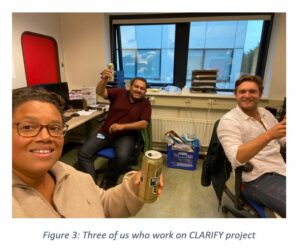I found myself in lockdown in a new country without getting the chance to settle first. No friends, no relations, no in-person communication.
I am from Iran, and I have a master’s degree in Biomedical Engineering. In recent years, I became interested in artificial intelligence, and it excites me I see how this field is changing the world. I have decided to perform my work and research on computer science and biomedical science interaction to pursue my academic field. Hence, I applied for one of the best projects on my end, and I moved to the Netherlands in September 2020 to do this thrilling project. This project means more than just research to me; Helping CLARIFY, I have the opportunity to improve my knowledge in the field of digital pathology and start a new era in my academic life.
Apart from research, my friendly team members, I found the Netherlands very beautiful. Unfortunately, my PCR test result was positive when I arrived in Amsterdam, and I had to go into quarantine for 14 days. I found myself in lockdown in a new country without getting the chance to settle first. No friends, no relations, no in-person communication.
But thanks to my beloved wife, who always accompanies me in challenging situations, I could overcome the emotional pressure from the unexpected circumstance (Figure 1). Immediately after my self-isolation, I was extremely passionate to visit EMC as soon as possible (Figure 2).

I mentioned above that my project is very exciting, now let me describe it from my point of view. Diagnosis and prognosis of urothelial cancer are performed via assessment of specific tissue and cellular features by pathologists. Importantly, intra and inter variability of pathologists can affect diagnosis. There is a need to develop methods for reducing the inconsistency of pathologic assessment.
Computer-aided Diagnosis (CAD) is a promising tool for automation of the diagnostic processes and reducing intra/inter variability in urothelial cancer diagnosis.
CAD is being utilized in image analysis too. However, there is no CAD currently available that employs pathological features in High-risk non-muscle invasive bladder cancer (HR-NMIBC) patients for diagnosis and prognosis. Our goal is to improve HR-NMIBC patient’s diagnosis by developing deep learning algorithms and using artificial intelligence to aid the diagnosis of HR-NMIBC patients via digital pathology. We aim to provide pathologists and clinicians with an accurate, affordable, and reproducible diagnostic and prognostic tool. Last but not least, I hope the outcome of this project will be available in the near future and contribute positively to wellness of the patients with efforts of this friendly team (Figure 3).

Farbod Khoraminia – ESR 10

